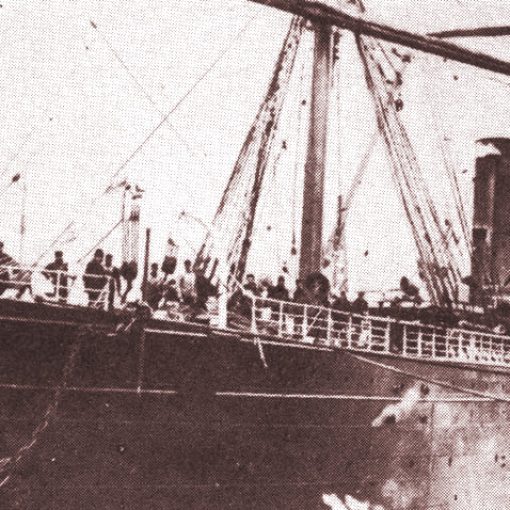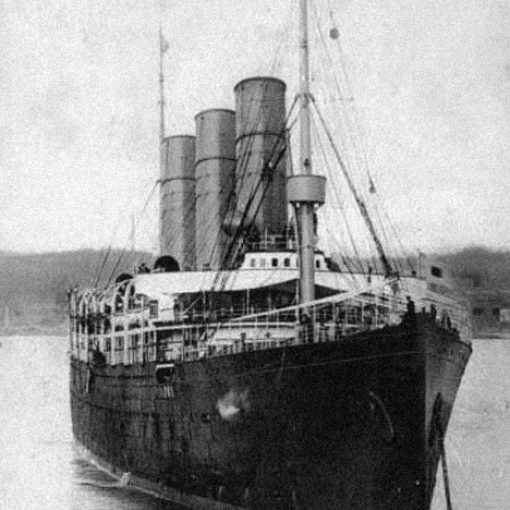1906 – 1931
Also known as Empress of Scotland (I)
When the Hamburg-Amerika Line put the Deutschland into service in 1900, they soon learned an important lesson. In the quest for speed, comfort could be lost. The Deutschland managed to win the Blue Riband, but her powerful engines caused the ship to vibrate and shake when she was travelling at high speeds. These vibrations were never remedied, and after only ten years the Deutschland would be refitted as a cruise ship.
The misadventures of the Deutschland led the Hamburg-Amerika Line’s managing director Albert Ballin to make a decision. From then on, the company would no longer emphasise speed, but rather size and comfort. The quest for the Blue Riband was abandoned and left for Hamburg-Amerika’s rival Norddeutscher Lloyd. With the company’s new policy of size and comfort in mind, Albert Ballin ordered new ships to be built. Two of these ships would be near-sisters, their names intended as Amerika and Europa. The Amerika was built by the Irish shipbuilders of Harland & Wolff in Belfast, and the Europa was laid down as ship no. 264 at the German firm Vulkan Shipyards of Stettin.
On August 29th 1905, the Europa was ready for her launch. But by now it had been decided to change her name. It had been arranged so that the Empress of Germany would launch the ship, and the company wanted to honour the Empress by giving their newest vessel her name. The Empress approved, and the ship was instead named Kaiserin Auguste Victoria. The work of fitting her out would soon begin.
On May 10th 1906, the Kaiserin Auguste Victoria left Hamburg on her premier voyage across the North Atlantic. Her destination was New York, and she would make stopovers at Dover and Cherbourg along the way. The ship was the largest ship in the world, yet she would only keep that title for a short time. In 1907, the Cunarder Lusitania entered service and was the first ship to exceed 30,000 tons.
The Kaiserin Auguste Victoria soon gained a reputation of being a very beautiful ship, at least on the inside. Outwardly, she seemed almost piled up, as if she had too many decks upon each other. She had a strange way of behaving in rough seas – she never really completed her rolls and moved about in irregular movements. But on the inside, the ship was known for her decorations. The man responsible for the interior design of both the Amerika and the Kaiserin Auguste Victoria was the French architect Charles Mewès. On the Amerika and Kaiserin, Mewès introduced the à-la-carte restaurant on the high seas. Inspired by the Ritz Carlton Hotel in London, they offered an alternative to the first class dining saloon. But where the meals in the dining saloon were included in the ticket-price, passengers had to pay a special admittance fee when dining in the à-la-carte restaurant. Ironically, this fee could cost the same as a one-way ticket in third class.
The Kaiserin Auguste Victoria was soon a very popular ship among the travelling public, most because of her luxurious interiors. Those who wanted to cross the North Atlantic swiftly did not go on the Kaiserin or the Amerika. Where the Deutschland had sped along at 22 knots, the two new ships would never reach a speed over 18 knots. For the next eight years, the Kaiserin Auguste Victoria continued to serve the Hamburg-Amerika Line in a very satisfactory way. But in 1914, the first sparks were ignited that would soon become the raging fire of World War I. No immediate task could be found for the Kaiserin, and she was laid up at Hamburg in August that year. She was eventually modified as a troopship, in case she would suddenly be needed as such. But as time would have it, the Kaiserin Auguste Victoria did not see any action for the entire conflict, but remained in Hamburg for the duration of the war.
When peace finally came in 1918, Germany and her allies had been defeated. The ruthless peace treaty of Versailles in 1919 meant that nearly all of Germany’s merchant ships were given to the victorious nations as reparations for sunken and destroyed ships. This included the Kaiserin Auguste Victoria as well, who was ceded to Great Britain where she arrived in March the same year. She was soon chartered to the US Shipping Board to be used as a repatriation ship for American troops.
In 1920, when her repatriation work had come to an end, the Kaiserin Auguste Victoria was chartered to the Cunard Line to fill a gap on the Liverpool-New York run. On February 14th, she made her first sailing for Cunard and she would remain in this service until the end of the year. On May 13th 1921, the Kaiserin Auguste Victoria was sold to the Canadian Pacific Railroad Company and was renamed Empress of Scotland. The ship was in need of an overhaul, and for this purpose she was sent back to her original builders in Stettin. The most notable change was that she was now converted into an oil-burner. Other modifications increased her tonnage with some 500 tons and her passenger accommodations were brought down by about a thousand.
The following year, on January 22nd, the Empress of Scotland made her maiden voyage for her new company on the route Southampton-New York. This was not to be her regular trade, though. When she reached New York, the Empress of Scotland was chartered to an American travel agency for a cruise to the Mediterranean. When she returned she was placed on her intended Southampton-Cherbourg-Quebec run. After a few crossings, Hamburg was added to her service route. In 1923, the Empress of Scotland suffered her first major mishap when she collided with the steamer SS Bonus in Hamburg. The damage sustained was only superficial though, and was fixed with easy repairs.
As time went on, it became clear that the world was different than it had been before the World War. To keep the Empress of Scotland up to date, Canadian Pacific changed her passenger system in 1927 by adding a tourist class. But this experiment was unsuccessful, and the Empress of Scotland was now beginning to lose money for the company. Subsequently, she was sold for scrap on December 2nd 1930, to the breakers of Hughes, Bolckow & Co, Blyth for £43,000.
The arrival of the Empress became a festive occasion for the people of Blyth. When the ship had been tied up at Battleship Wharf on December 4th, she was opened up for public viewing days during which her fittings would be auctioned off. A great many people came to Blyth for the occasion, and during the following weekend nine pianos, settees and easy chairs in French velvet, carpets, rugs, oil paintings and much more were sold to anxious buyers. Voluntary stewards sold item catalogues at a shilling each, and these earnings went to the town hospital. At one point, so many people were on board that the gangway had to be closed.
On the last public view day, December 10th, the yard’s skeleton crew on board the Empress of Scotland was awakened by the cry of fire – the stern of the ship was ablaze. The Harbour Commissioner’s fire float was soon at the scene, along with the town’s fire brigade. But the fire had already gotten a firm hold, and soon flames 20 feet high were ravaging the Empress. Throughout the day, more than a hundred firemen battled the raging fire, which apparently had started in the Tourist Class Barber’s Shop. But their efforts were in vain, and the tremendous heat caused much damage to the burning ship. By nightfall, the mooring cables had burned through, and the ship’s masts were swaying, causing fear that they might topple onto the yard. At first, it was planned to tow the Empress into the river, but it proved impossible to get the lines on board the burning hulk. Instead, she was scuttled where she lay.
Four days later, the fire had finally died out completely. What was left was a twisted and burned-out hulk, sitting on the riverbed. Most of the sold fittings had not been removed when the fire had started, and by now it was all destroyed. All that was left to do was to start the demolition and on December 15th, work could finally begin. During the following months, the two funnels and part of the superstructure were cut down. At the end of February, the Empress was refloated and pumped dry to allow for further demolition. This lasted until May, at which point the Empress was to be towed to the Tidal Dock for final cutting up. Unfortunately, there was still bad fortune in store.
On June 1th 1931, while under tow, the weakened structure of the ship collapsed. The Empress of Scotland broke in two, by now a sad shadow of her once glorious self. By October 1931, her last remains had been cut up.
Specifications
- 705 feet (215.3 m) long
- 77 feet (23.5 m) wide
- 24,581 gross tons as originally built, 25,037 gross tons when refitted as the Empress of Scotland
- Steam quadruple-expansion engines turning two propellers
- 17.5 knot service speed
- Passenger capacity of 2,996 people as originally built, 1,897 people as the Empress of Scotland












2 thoughts on “Kaiserin Auguste Victoria”
My great grandparents and grandmother sailed on Kaiserin Auguste Victoria, leaving Hamburg 27 Jan 1912. I have been searching for information on the port they would have arrived at in New York. The passenger list provides the date of departure, but not the date of arrival. I wonder how long their journey was. They traveled second class. Would they have been privy to the amenities this beauty had to offer? Thank you for any additional information you might provide.
My Great Uncle sailed to New York to visit his step brother enabling me to find out where my grandfather had disappeared to
Arrival
6 June 1920 • SS KAISERIN AUGUSTE VICTORIA New York USA
was great to find this site.